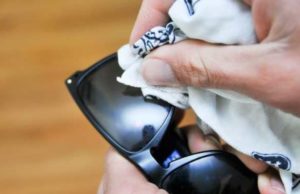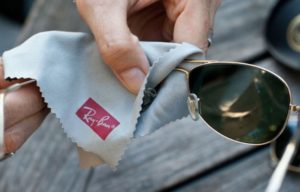Sunglasses have become so firmly established in our daily lives that they are an integral attribute of almost any person, combining style and functionality.
High-quality glasses are expensive, especially if they are selected taking into account individual vision characteristics. And it’s even more offensive when they fail or become defective. This happens, most often, as a result of careless handling and ignorance of the rules of operation and maintenance.
Is it possible to remove scratches on sunglasses?
You can restore the surface of optical lenses yourself at home using available products. Knowing the algorithm and polishing technology, you can quickly get rid of small and insignificant scratches. If there are deeper defects, you will have to put in more effort and time.
Important! You should choose a method for removing scratches on lenses depending on the material they are made of.
Removing the top layer on sunglass lenses
 An effective way to remove scratches of any depth from plastic glasses is removing the top coating. In this case, at the end of the procedure, the lens acquires a smooth surface without flaws.
An effective way to remove scratches of any depth from plastic glasses is removing the top coating. In this case, at the end of the procedure, the lens acquires a smooth surface without flaws.
Initially follows Clean your sunglasses from dust and dirt – microcracks attract them to themselves like a magnet.
To remove the top layer use hydrofluoric acid products. You must first remove the lenses from the frame. The required amount of the drug is applied to their surface, then placed for 1–2 minutes in a plastic container for chemical exposure. After time, rinse thoroughly with water.
Important! Hydrofluoric acid is highly toxic, so when working with it, you must take precautions and use personal protective equipment.
Along with the removal of the outer layer, all protective coatings are removed, which makes the glasses more vulnerable to external mechanical influences.
Differences in polishing of glass and plastic lenses
 As a rule, the same available products are used to polish glass and plastic lenses. An exception is made for some methods due to the excessive sensitivity of the materials to certain substances. For example, Hydrofluoric acid should never be used on glass – this will lead to its final damage.
As a rule, the same available products are used to polish glass and plastic lenses. An exception is made for some methods due to the excessive sensitivity of the materials to certain substances. For example, Hydrofluoric acid should never be used on glass – this will lead to its final damage.
You need to be extremely careful with glass, as it is fragile. But when cleaning it, you can use more granular substances.
The plastic has a multi-layer coating, so when using preparations with abrasive particles there is a risk of damaging it and depriving it of the protection provided by the manufacturer.
Scratch removers
The following are effective for removing scratches of varying depths from plastic optical products:
- special abrasive gel from the optical salon;
- polish for wood or copper and silver;
- CD polishing spray;
- toothpaste (without abrasive particles);
- liquid for car glass (with wax);
- glass washer;
- baking soda;
- clear nail polish.
Glass lenses are cleaned using all the means described above. The most effective is GOI paste containing chromium oxide.
How to remove small scratches?
Important! All manipulations should be carried out with extreme care and precision.
The technology is as follows:
- cleansing;
- applying polishing compounds, rubbing in a circular motion from the edges to the center until the cracks are completely filled or eliminated;
- rinsing under running water, followed by wiping dry with a soft cloth (suede, microfiber).
Sanding a large surface
In the case when there are a lot of scratches on glass glasses and they tightly cover the entire surface, use:
 a grinding machine or drill, pre-wrapped in felt or foam material;
a grinding machine or drill, pre-wrapped in felt or foam material;- If they are missing, you can use an electric razor by removing the mesh and replacing it with soft cloth, attaching it, for example, with thread.
Then a cleaning composition is applied to the fabric and, turning on the device, polished until the scratches are completely eliminated.
How to remove deep scratches
To eliminate deep scratches, you can use the methods of removing the top coating or grinding with GOI paste using mechanical devices. These methods acceptable if defects are located at the edges of the lens. If they are located in the center, there is no need to restore the sun-protection accessory.
Important! Ophthalmologists do not recommend using deeply scratched glasses, because when they are polished, the layers of material applied by the manufacturer are micro-removed, which leads to a change in the geometry of the lens and a violation of its optical properties. In the future, frequent wearing of such glasses can lead to visual strain, general fatigue, headaches and decreased vision.
Prevention measures
Avoiding problems with sunglasses will help proper care and careful handling. Strictly follow the manufacturer's recommendations, the basic rules and glasses will serve you for a long time:
 store only in a special hard case of the appropriate size;
store only in a special hard case of the appropriate size;- subject to regular cleaning with soap suds or special wipes, sprays;
- additionally purchase and apply protective films;
- do not use acetone-containing compounds or abrasive substances;
- do not place lenses face down on hard surfaces;
- Do not expose to too high or low temperatures, do not leave in the open sun or car panels;
- remove the frame, holding the temple with both hands;
- use glasses only for their intended purpose (do not, for example, wear them as a hairband);
- Avoid contact with the product with varnishes, air fresheners, and other chemicals.




 0
0





